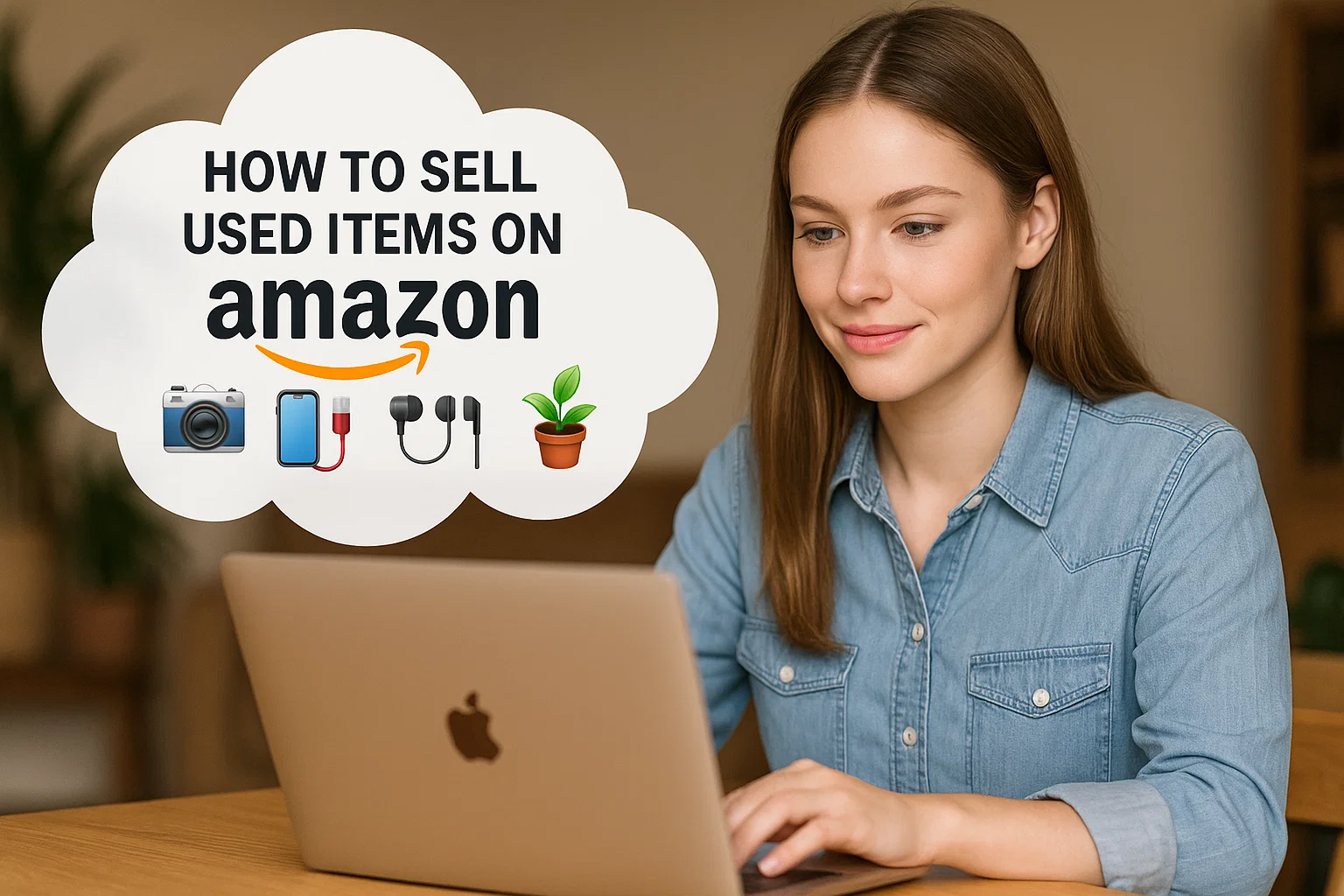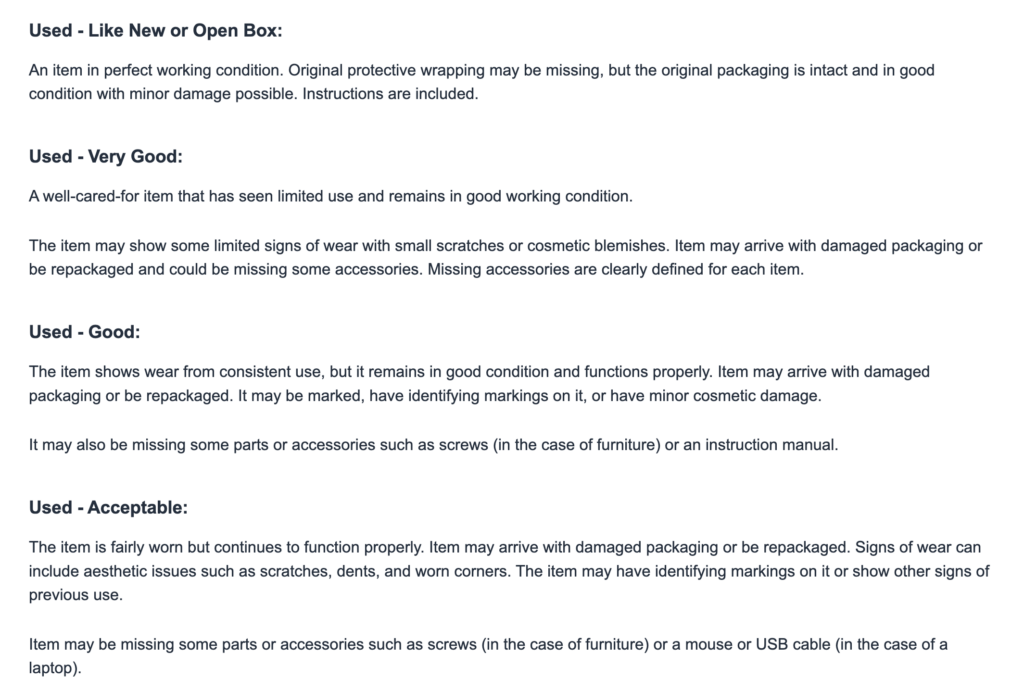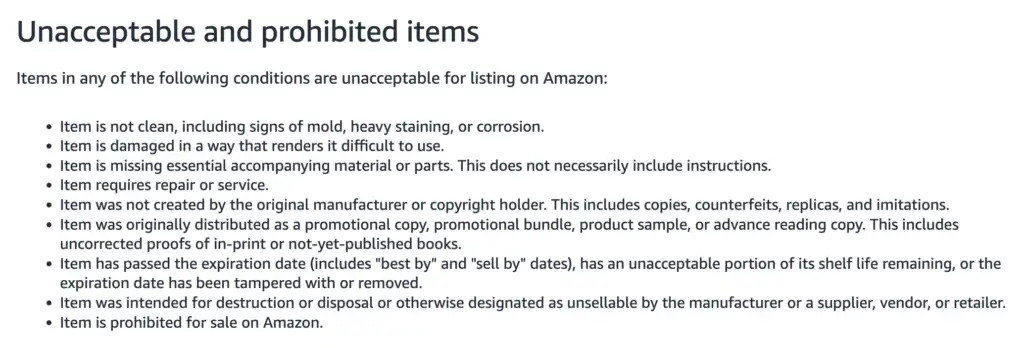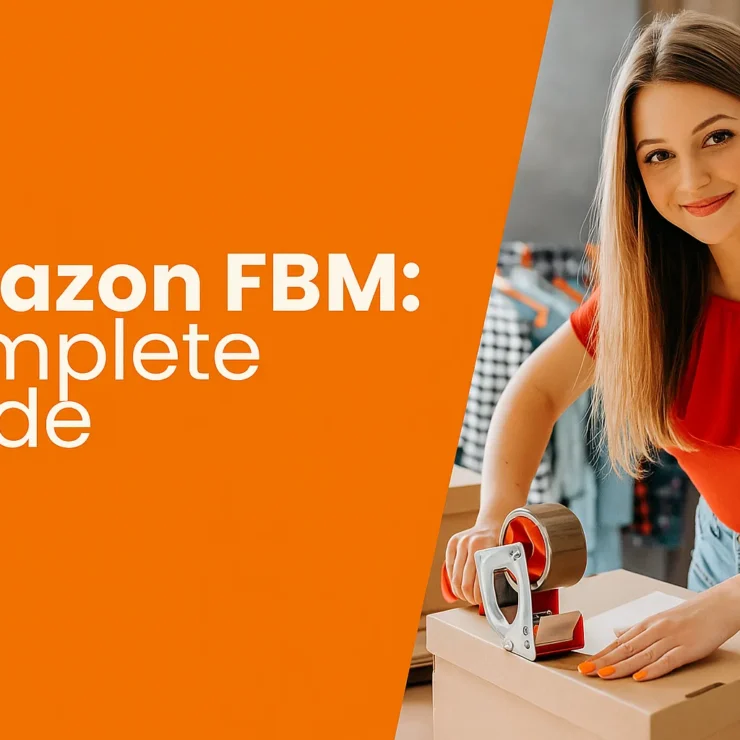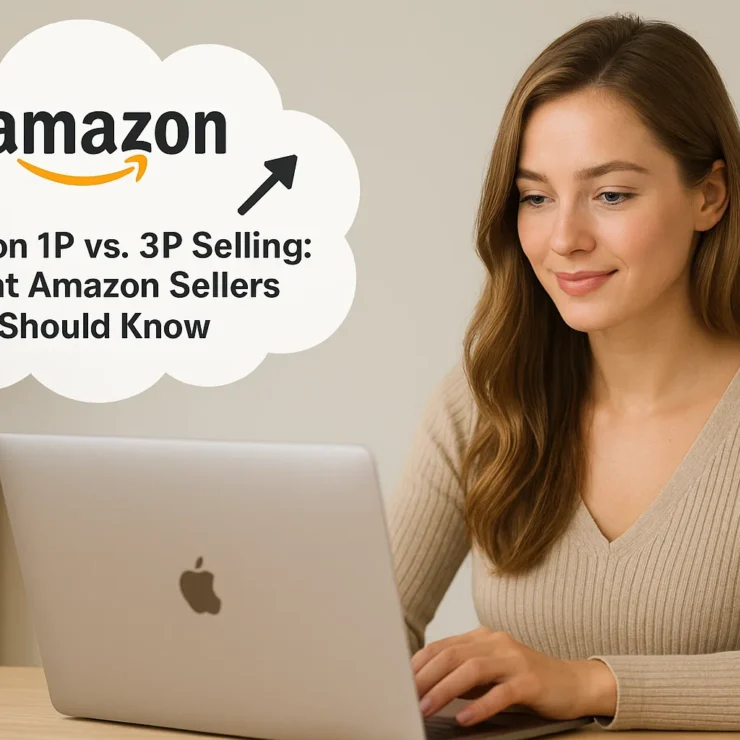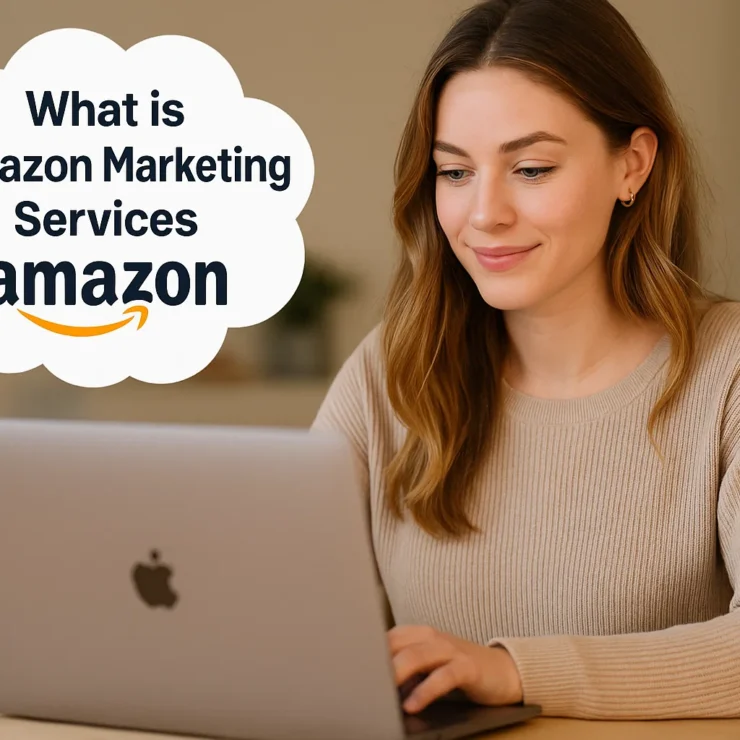The resale and recommerce industry is booming — and Amazon is no exception. In 2025, more people than ever are buying and selling pre-owned goods online, driven by the global shift toward sustainability, affordability, and conscious consumerism. From refurbished gadgets to gently used books, secondhand products have evolved from a niche market to a multi-billion-dollar industry — and Amazon is at the center of it all.
If you’ve ever wondered “Can I sell used items on Amazon?” — the short answer is yes, you can. But, like most things on Amazon, it comes with specific rules, category restrictions, and quality standards you’ll need to follow. Selling used products isn’t as simple as just listing old items from your garage. Instead, it’s about understanding Amazon’s policies, creating accurate listings, maintaining trust with buyers, and optimizing your business to compete in one of the world’s largest eCommerce ecosystems.
This 2025 guide will walk you through everything you need to know about how to sell used items on Amazon — from understanding what “used” means in Amazon’s terms to finding profitable product categories, managing fulfillment, and staying compliant with policy updates.
Save time and scale efficiently with the top Amazon FBA automation companies of 2025 offering powerful business growth solutions.
Selling used items on Amazon: What’s allowed and what’s not
If you’re just starting your Amazon venture, selling used, pre-owned, or slightly used items can be an excellent way to understand the platform and gain valuable experience as a seller. It’s not only a low-cost entry point into eCommerce but can also be a profitable business model for both new and experienced Amazon sellers looking to diversify their income streams.
However, not every used or second-hand product is eligible for sale on Amazon. The marketplace has clear, category-specific rules that sellers must follow to maintain quality, safety, and buyer trust.
To help you navigate these rules effectively, here’s a breakdown of which categories allow used items and which do not—based on Amazon’s most recent (2025) guidelines.
Categories That Allow the Sale of Used Items
Amazon provides a wide range of product categories where you can legally and safely sell used goods. Sellers just need to list items in the correct category, describe their condition accurately, and meet Amazon’s performance standards.
Here’s the list of product categories where selling used items is allowed:
Amazon Device Accessories
Amazon Kindle
Books
Camera & Photo
Cell Phones & Accessories
Consumer Electronics
Home & Garden
Industrial & Scientific
Kindle Accessories & Amazon Fire TV Accessories
Major Appliances
Music and DVD
Musical Instruments
Office Products
Outdoors
Personal Computers
Pet Supplies
Software
Sports
Tools & Home Improvement
Video, DVD & Blu-ray
Video Games
Note:
Some subcategories within these may still require Amazon’s approval before you can list used items. For instance, selling refurbished electronics or certain software versions may need pre-authorization.
These categories are ideal for reselling, refurbishing, or flipping pre-owned items — whether you’re sourcing from garage sales, returns, estate sales, or your own unused goods.
Categories That Don’t Allow the Sale of Used Items
While Amazon welcomes used goods in many categories, others are strictly restricted due to safety, hygiene, or authenticity concerns. Sellers are not allowed to list used items in these categories:
Baby Products (excluding apparel)
Beauty
Collectible Coins
Entertainment Collectibles
Fine Art
Grocery & Gourmet Foods
Health & Personal Care
Independent Design
Sports Collectibles
Toys & Games
Watches
Amazon enforces these restrictions to ensure customer safety, product authenticity, and compliance with legal standards. For example, health and beauty products, foods, or baby items must always be new and sealed because they come into direct contact with the body or are meant for infants.
Discover what Amazon Attribution is and how sellers can use it in 2025 to track and optimize marketing campaigns.
Understanding Amazon’s Used Product Conditions
When learning how to sell used items on Amazon, understanding Amazon’s condition guidelines is crucial. The way you categorize and describe your used products determines whether buyers trust your listings — and whether your account remains in good standing.
Amazon defines very specific conditions for used products to help maintain transparency and consistency across listings. These guidelines ensure that customers receive exactly what they expect and help sellers reduce return rates or negative feedback.
Below is a detailed breakdown of Amazon’s used product condition categories that you must follow when selling pre-owned or second-hand products in 2025.
Used – Like New or Open Box
The item is in perfect working condition with intact original packaging and in good condition, with minor damage possible, with or without original protective wrapping. Instructions must be included.
Used – Very Good
The item has been well-cared-for, has undergone limited use, and is still in good working condition. It may show limited signs of wear, such as small scratches or cosmetic errors. The original packaging may be damaged, or the item could be repackaged. Any missing accessories must be clearly defined for each item.
Used – Good
The item is in good condition and is fully functional but shows signs of wear from consistent use. It may arrive repackaged or with damaged packaging. It may have markings and minor cosmetic damage. It may be missing parts, accessories, or instructions.
Used – Acceptable
The item is still functional but is fairly worn and has been repackaged or is in damaged original packaging. It bears signs of wear such as scratches, dents, worn corners, or identifying markings. Parts, accessories, and instructions may be missing.
According to Amazon, the following conditions are unacceptable to be listed on Amazon:
The item is dirty with mold, heavy staining, corrosion, or other signs of uncleanliness.
The item has damage that impacts its ability to be used.
The item is missing parts or accessories that are essential for use (excludes instructions).
The product needs repairs.
The item is a copy, counterfeit, replica, or imitation of an original product.
The item was created for promotional purposes, such as a product sample or advance reading copy.
The item is expired or close to expiring, per its expiration date (including “best by” and “sell by” dates), or the expiration date has been altered or removed.
The item was designated unsellable by its manufacturer.
Pro Tip: Always Be Honest in Condition Descriptions
When listing a used product on Amazon, it’s essential to accurately designate its condition. Nothing frustrates customers more than receiving an item described as “Used – Like New” that turns out to be “Used – Acceptable.”
To ensure customer satisfaction and protect your seller reputation, it’s generally better to list your item one condition below what you believe it to be.
For example:
If you think it’s Like New, list it as Very Good. This approach not only prevents negative reviews but also increases the likelihood of positive feedback and repeat purchases.
Learn what Amazon BSR means and how this crucial ranking metric affects product visibility and long-term sales success.
Where to Find Profitable Items to Sell on Amazon
Finding good inventory is the most important step for success when you want to sell used items on Amazon. You need sources that reliably offer products at low cost, acceptable condition, and with good demand. Below are the best places and methods to find those items — along with tips to make sure you pick profitable ones.
Thrift Stores, Garage Sales & Estate Sales
One of the classic sources for used inventory.
Thrift shops often have items donated or lightly used. You can get items for very low cost and sometimes find unique, vintage, or collectible pieces that sell at a premium.
Garage sales and estate sales are treasure hunts: people often sell things without knowing full market value, so you can pick up valuable items for low cost.
Important: inspect condition carefully. Look for flaws, missing parts, wear, and whether the item’s condition description on Amazon’s used categories would accept it. If you misjudge, return rates or negative feedback could kill profit.
Retail Arbitrage & Clearance Sections
Retail arbitrage means buying deeply discounted or clearance inventory and reselling it on Amazon.
Big-box stores like Walmart, Target, HomeGoods, Ross, Burlington, and discount chains often have clearance aisles with items deeply discounted. If you can buy at 50-75% below usual retail, there’s room for good profit.
Use the Amazon Seller App or scanning tools to check if the item is selling well, what its condition is, and what fees and competition you’ll face.
Online arbitrage is similar, but you find clearance or discounted items online (e.g., other retailers’ websites, discount e-tailers) and resell them on Amazon.
Liquidation, Returns & Overstock Sources
These sources give access to bulk, surplus, or returned items that retailers no longer want to hold.
Liquidation companies like Liquidation.com, DirectLiquidation, or surplus stock sellers provide lots of overstock or returned items. If you can filter for condition, you might get good deals.
Returns: Sometimes retailer returns are sold in bulk. You may be able to refurbish or clean items and resell them as used or refurbished.
Be cautious: returned items might have undisclosed damage. Always inspect or request pictures / truthful descriptions before buying.
Online Resale Platforms & Marketplaces
You can source from other secondary marketplace sellers.
eBay, Mercari, Poshmark, ThredUp etc. Many items listed used there are underpriced compared to Amazon. You can buy and flip them, provided condition and category allow.
Also look for bundles or lot sales — buying several items in a lot can reduce acquisition cost per item
A step-by-step guide on how to create an Amazon Storefront in 2025 to boost brand identity and customer trust.
How to Sell Used Items on Amazon (Step-by-Step)
Listing used items for sale on Amazon is a straightforward process that can be completed in just a few easy steps. The process is very similar to listing a new product, but with special attention to accurately describing your item’s condition. Here’s how to get started:
Step 1: Create an Amazon Seller Account
To begin selling, you’ll first need to set up an Amazon Seller Account. Amazon offers two types of accounts — Individual and Professional:
Individual Account:
This plan is free to join, but you’ll be charged a $0.99 fee for every item you sell. It’s best suited for sellers who plan to sell a few used or second-hand items occasionally.Professional Account:
This plan costs $39.99 per month but removes the per-item fee and provides access to advanced selling tools, bulk listing uploads, and advertising features. It’s ideal if you plan to sell used goods at scale or source inventory regularly from other marketplaces, thrift stores, or wholesale suppliers.
Tip:
If you’re just testing the waters, start with an Individual account to assess your profitability. Once you see consistent sales and growth, you can upgrade to a Professional account anytime.
Step 2: Choose a Fulfillment Method
After setting up your seller account, the next step is to decide how you’ll fulfill your orders. Amazon offers two fulfillment methods — Fulfillment by Amazon (FBA) and Fulfillment by Merchant (FBM).
Fulfillment by Amazon (FBA):
With FBA, Amazon takes care of storage, packaging, shipping, returns, and customer service on your behalf. You simply send your used inventory to an Amazon fulfillment center. FBA is ideal for sellers dealing with bulk quantities or those who want a hands-off approach to logistics.Fulfillment by Merchant (FBM):
In this method, you handle storage, packaging, shipping, and customer service yourself. FBM is perfect for sellers with smaller inventories or those who prefer to maintain full control over their used products and shipping costs.
While FBA offers convenience and Prime eligibility, the fees depend on an item’s size and weight — which can eat into your profits for lower-priced used items. If you have the ability to pack and ship products efficiently, FBM can often provide better margins for used goods.
Step 3: Create the Product Listing
Once your account and fulfillment method are set, it’s time to create your product listing. Amazon requires that sellers do not create duplicate listings for products already listed on the platform.
Here’s how to list your used product correctly:
Find the ASIN (Amazon Standard Identification Number) of the item you want to sell. You can find this under the “Product Information” section of an existing listing.
(For books, look for the ISBN — International Standard Book Number — instead. Older books without ISBNs can be found by searching by title.)Log in to Seller Central and go to the “Inventory” tab.
Click “Add a Product.”
Paste the ASIN (or ISBN) into the search bar and locate the product.
Click on “Sell this product.”
On the Offer page, choose the correct condition (Used – Like New, Very Good, Good, or Acceptable) based on Amazon’s Used Condition Guidelines.
Add a detailed Condition Note that clearly describes the item’s wear, packaging, or any missing accessories. Transparency helps you build trust and avoid negative feedback.
Set a competitive price, add images (if allowed), and publish your listing.
Special Note for Used Books:
If your book doesn’t have an ISBN (common for editions before the 1970s), search by the title or author name. Once found, click “Sell on Amazon” and follow the same listing process.
Step 4: Optimize Your Listing for Visibility & Conversion
When optimizing your product listing you have to:
Write a clear, keyword-rich title (avoid fluff).
Include in description & bullets: features, specs, condition, what’s included, what’s missing.
Use high-quality images showing the actual item and its imperfections.
Use keyword research tools or analyze competing listings to find relevant search terms.
Price competitively considering condition, fees, and market demand.
Successful sellers rely on Amazon product research in 2025 to find winning products and gain a competitive edge.
How to Sell Certified Pre-Owned and Refurbished Products with Amazon Renewed
The Amazon Renewed Program is an excellent opportunity for sellers to offer customers high-quality, “like new” products with confidence.
Backed by the Amazon Renewed Guarantee, this program assures buyers that every certified item has been tested, inspected, and verified to function and appear almost identical to new. Customers also benefit from up to 90 days of Amazon-supported customer service after purchase — a major factor that builds trust and encourages repeat sales.
For sellers, joining this program means submitting products for Amazon’s approval to ensure each meets strict quality standards. Items must be fully functional, in near-perfect cosmetic condition, and come in their original or equivalent packaging.
Through the Amazon Renewed Program, sellers can offer a variety of refurbished and pre-owned items, such as:
Smartphones
Cameras
Headphones
Kitchen Appliances
Power Tools
Laptops and PCs
Tablets
Televisions
Gaming Consoles
To qualify as an Amazon Renewed seller, you must meet the following requirements:
Provide supply invoices showing at least $50,000 in qualifying refurbished purchases within the last 90 days.
Maintain an Order Defect Rate (ODR) of 0.8% or less over the previous 90 days.
Submit eight high-resolution product images (including packaging) for Amazon’s inspection if the product is factory refurbished.
Guarantee all refurbished products under the Amazon Renewed Guarantee, taking responsibility for any related claims.
For Apple products in the Consumer Electronics category, provide invoices totaling $2.5 million in Apple refurbished goods from the past 90 days.
This program not only boosts customer confidence but also helps sellers expand into the fast-growing refurbished goods market on Amazon.
Discover how Amazon Merch on Demand in 2025 empowers creators to monetize designs without upfront inventory costs.
Best Practices for Selling Used Products on Amazon
Selling used items on Amazon can be highly profitable if done strategically and transparently. To build customer trust and maintain a positive seller reputation, it’s crucial to follow Amazon’s policies and implement best practices that ensure a smooth and reliable selling experience.
Accurately Describe Product Condition
Always be honest about your product’s condition. Use Amazon’s specific condition categories—Used – Like New, Very Good, Good, or Acceptable—and describe your items accurately in the product listing. Include detailed notes about minor flaws, missing accessories, or repackaged boxes. Setting accurate expectations helps you avoid returns and negative reviews.
Take High-Quality Photos
Good product images are key to attracting buyers. Use clear, high-resolution images that show the item from multiple angles, including any wear or imperfections. Real photos (not stock images) build authenticity and boost buyer confidence, especially when selling used products.
Set Competitive Pricing
Used items must be priced attractively to compete with new listings. Research similar listings on Amazon to find the ideal price range. If your item is in excellent condition or includes extras (like original packaging or accessories), you can price it slightly higher than other used listings.
Provide Excellent Customer Service
Respond promptly to customer inquiries, handle returns professionally, and maintain a low Order Defect Rate (ODR). Exceptional customer service can turn first-time buyers into repeat customers and increase your chances of earning the Amazon Pro Seller Badge or even qualifying for Amazon Renewed.
Follow Amazon’s Policies
Stay updated with Amazon’s seller guidelines, especially regarding restricted categories and condition rules. Selling items that violate Amazon’s standards can lead to account suspension or removal of listings.
By following these best practices—honesty, transparency, and professionalism—you’ll build long-term trust with customers, strengthen your brand reputation, and create a profitable business selling used items on Amazon.
To better understand your ad performance on Amazon, check out our guide on how to calculate ACoS in 2025.
Conclusion: How to Sell Used Items on Amazon
Selling used items on Amazon in 2025 continues to be a smart and sustainable business opportunity for both new and experienced sellers. With millions of active buyers looking for affordable, high-quality alternatives to new products, the demand for used and refurbished goods is stronger than ever. Whether you’re reselling books, electronics, or collectibles, success depends on understanding Amazon’s rules, accurately describing your product’s condition, and providing exceptional customer service.
By following best practices, exploring programs like Amazon Renewed, and maintaining a customer-first approach, you can turn selling used products into a profitable and long-term venture on the world’s largest online marketplace.
Discover how to sell on Amazon without holding inventory, and start your business in 2025.
Frequently Asked Questions: How to Sell Used Items on Amazon
Can You Sell Open Box Items on Amazon?
Yes, you can sell open box items on Amazon as long as they meet the platform’s quality and condition requirements. Open box items generally fall under the “Used – Like New” category, meaning the product must be fully functional, in perfect condition, and include all original accessories. Packaging may have been opened or slightly damaged, but the product itself should be indistinguishable from new. Always be transparent in your listing description and include clear photos to help buyers understand exactly what they’re purchasing.
Is Selling Used Items on Amazon a Good Long-Term Strategy?
Absolutely. Selling used items on Amazon can be a profitable long-term business model if managed correctly. Many top-rated sellers build sustainable income streams by sourcing high-demand used products like electronics, books, and tools. As long as you maintain high product standards, competitive pricing, and stellar customer feedback, you can enjoy consistent sales and recurring profits. Plus, Amazon’s growing focus on sustainability and circular commerce means that selling used products aligns perfectly with consumer trends in 2025.
Can you sell used items through Amazon?
Yes, you can sell used items through Amazon, but only within approved product categories. Amazon allows the sale of gently used or pre-owned items in categories such as Books, Electronics, Home & Garden, Tools, Video Games, and Musical Instruments, among others.
To list a used item, sellers must choose the correct condition category (Used – Like New, Very Good, Good, or Acceptable) and accurately describe the item’s state. Transparency is key — misleading buyers about an item’s condition can lead to returns or account penalties.
A complete guide to Amazon Brand Registry in 2025 and how it helps protect and grow your brand.
Power Your Brand. Automate Your Growth. Win on Amazon — with Stores Automation
At Stores Automation, we specialize in automating every aspect of your Amazon store, from inventory management to marketing strategies, so you can focus on scaling your business. Our Done-For You Amazon Store service takes the guesswork out of e-commerce by providing expert solutions tailored to your store’s needs.
Whether you’re a seasoned seller or just getting started, we provide personalized automation that works for you — driving sales and freeing up your time.
Call us at 302-204-8244
Email: info@storesautomation.com
Sign Up to get started.
Let’s turn your Amazon store into a sales powerhouse. Book your free consultation today — and unlock your brand’s full potential with Stores Automation.
